Related topics
The war in Gaza is still far from over, 50 hostages are still there, both dead and alive, but some are already planning the future - not the political or military, but rather the architectural one. While US President Donald Trump fantasizes about turning Gaza into the"Riviera of the Middle East,"
In what is called "Trump's vision for Gaza"
, with luxury hotels and glittering towers, the reality on the ground tells a different story. Since the beginning of the fighting, various proposals have been made for the reconstruction of Gaza – some theoretical, others more practical. Now, for the first time, a comprehensive and well-founded report has been published, proposing an operational plan for the reconstruction of the Strip on the day after the war. Behind the initiative is an Israeli-American architect living in New York, who proposes an innovative approach to reconstruction based on four central principles. What does the plan include, and how is an Israeli architect behind it?
70% of homes were damaged, there is 42 million tons of debris
Since the IDF entered Gaza following the October 7 attack and the outbreak of the"Iron Swords" war, the Strip has changed beyond recognition. The new report reveals the unprecedented scale of the destruction: more than 70% of the housing stock in Gaza has been damaged or completely destroyed, along with critical infrastructure such as roads, the electricity grid and the water supply. The report also notes that the destruction left behind up to 42 million tons of construction waste, the vast majority of which is from demolished residential buildings. But beyond the numbers, the report points to a long and complex reconstruction process, if and when it begins, that is expected to take decades and involve enormous resources. Estimates speak of more than $50 billion that will be needed to try to return Gaza to its pre-war condition.
According to the report, there are approximately 42 million tons of construction waste (Photo: Eyad BABA / AFP)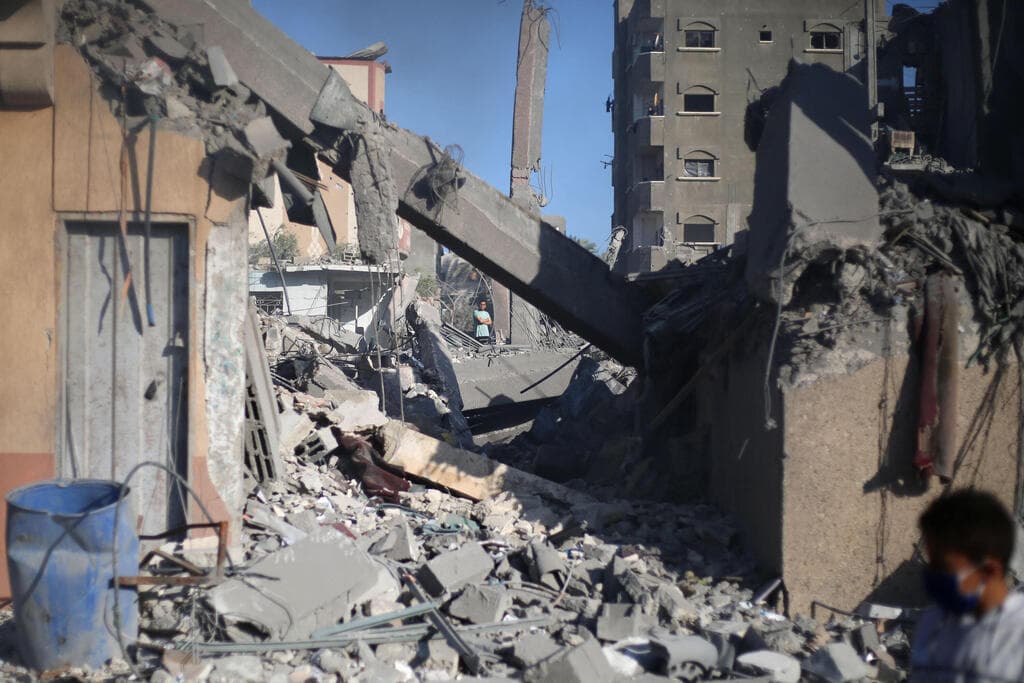
The report, titled From Camps to Communities: Post-Conflict Shelter in Gaza, is an initiative of the American non-profit think tank RAND, in collaboration with the architectural firm ORG Permanent Modernity with branches in New York and Brussels. One of the authors of the program is the Israeli-American architect and urban planner Kobi Rotenberg, an expert in long-term international strategic plans. Rotenberg works primarily on the global stage and is involved in complex projects around the world, focusing on creating innovative solutions for the restoration and improvement of urban textures damaged by conflicts. Among other things, he took part in a project to design flood protection and climate change adaptation infrastructure in New York, a plan to establish a new agricultural city in Ghana, and a national plan for the development of secondary cities and rural areas in Malawi.
Architect Kobi Rotenberg, courtesy of the photographer
The collaboration between Kobi's office and RAND actually began before October 7, back in 2022, when the team initially focused in a different direction."It was generally intended to be a strategic plan for the development of urban infrastructure throughout Palestine, including the West Bank and Gaza. The original goal was to create a set of tools and policy documents for all decision-makers - Palestinians, Israelis, Americans, Europeans and Arab countries," explains Rotenberg. And as mentioned, following the war in Gaza, it was decided to expand the original plan:"Since the war, we have begun working in parallel on a stabilization and reconstruction plan, which we began working on about two or three months after October 7. The goal of the plan is to prepare for the day after and provide realistic solutions for the reconstruction of the Strip, while supporting decision-makers on all sides," he adds.
The plan for the reconstruction of Northern Gaza (Drawing: ORG Permanent Modernity for RAND (2025))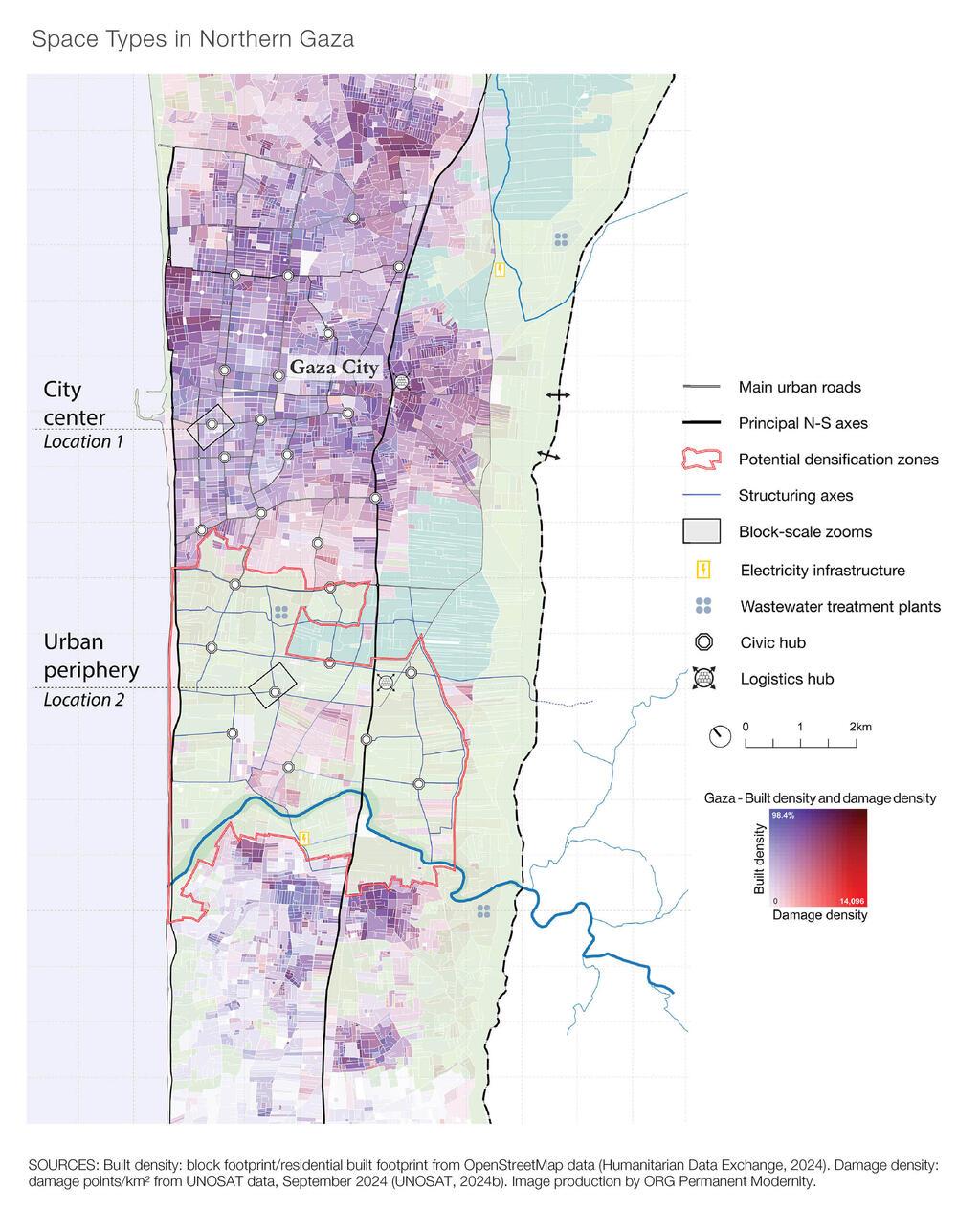
Types of buildings are proposed according to the length of stay, from camps to permanent homes (Drawing: ORG Permanent Modernity for RAND (2025))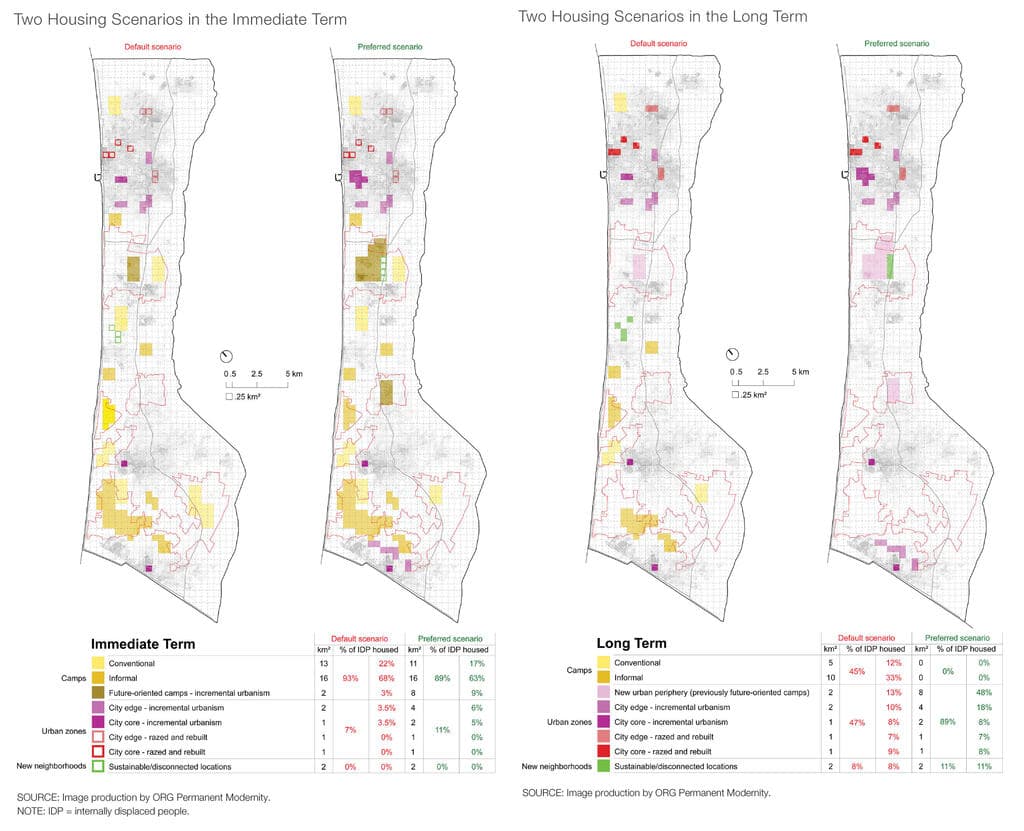
Decent living conditions with advanced infrastructure
The report actually seeks to deal with the complex situation in Gaza and find a way to plan sustainable rehabilitation for the residents of the Strip, in a way that will allow not only reconstruction but also a fundamental change in the concept of housing in the Strip, while at the same time preventing terrorist organizations from using rehabilitation to their advantage. In this context, Rotenberg says that"the report offers applicable solutions from the fields of urban planning for massive population in the short term while addressing critical considerations for long-term planning with an emphasis on social and economic stabilization and de-radicalization."
The rehabilitation plan is divided into four main principles, or more precisely, four rehabilitation options. The first principle proposes an interim solution: establishing temporary housing for hundreds of thousands of Gazans who will need shelters for a decade or more (roughly half of the population in the Strip), until their permanent homes are restored or rebuilt. The second principle focuses on the rehabilitation and renovation of entire neighborhoods, utilizing open spaces between the destroyed areas to create a restored and modern living environment. The third principle deals with developing an innovative model for planning refugee camps, so that they do not become centers of unbearable poverty and overcrowding, but rather offer decent living conditions with advanced infrastructure."The report changes established concepts of planning for refugees and seeks to prevent the repetition of past mistakes," claims Rotenberg, emphasizing:"The basic premise is that today's temporary is tomorrow's permanent, and any future plan will require taking this into account."
The latter principle proposes the redesign of new neighborhoods on undeveloped land throughout the Strip, with the aim of expanding residential options and building a progressive and functioning urban environment."The report offers a menu of options and spatial considerations for housing more than a million refugees for a period of more than 15 years, while taking into account the Russian terrain conditions, the quantities of explosives that require handling, and the complex logistical environment during reconstruction work," notes Rotenberg.
From refugee camps to neighborhoods (Drawing: ORG Permanent Modernity for RAND (2025))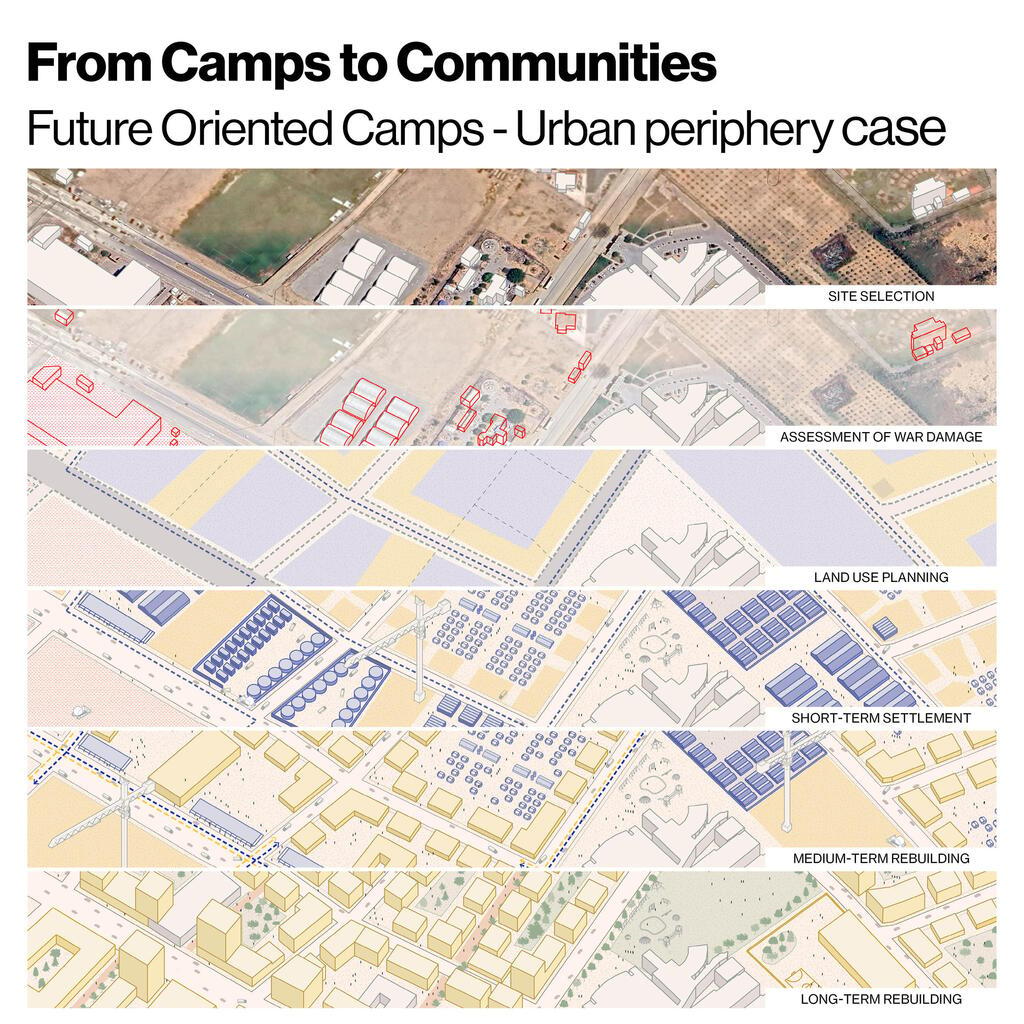
The plan for the restoration of the city center (drawing: ORG Permanent Modernity for RAND (2025))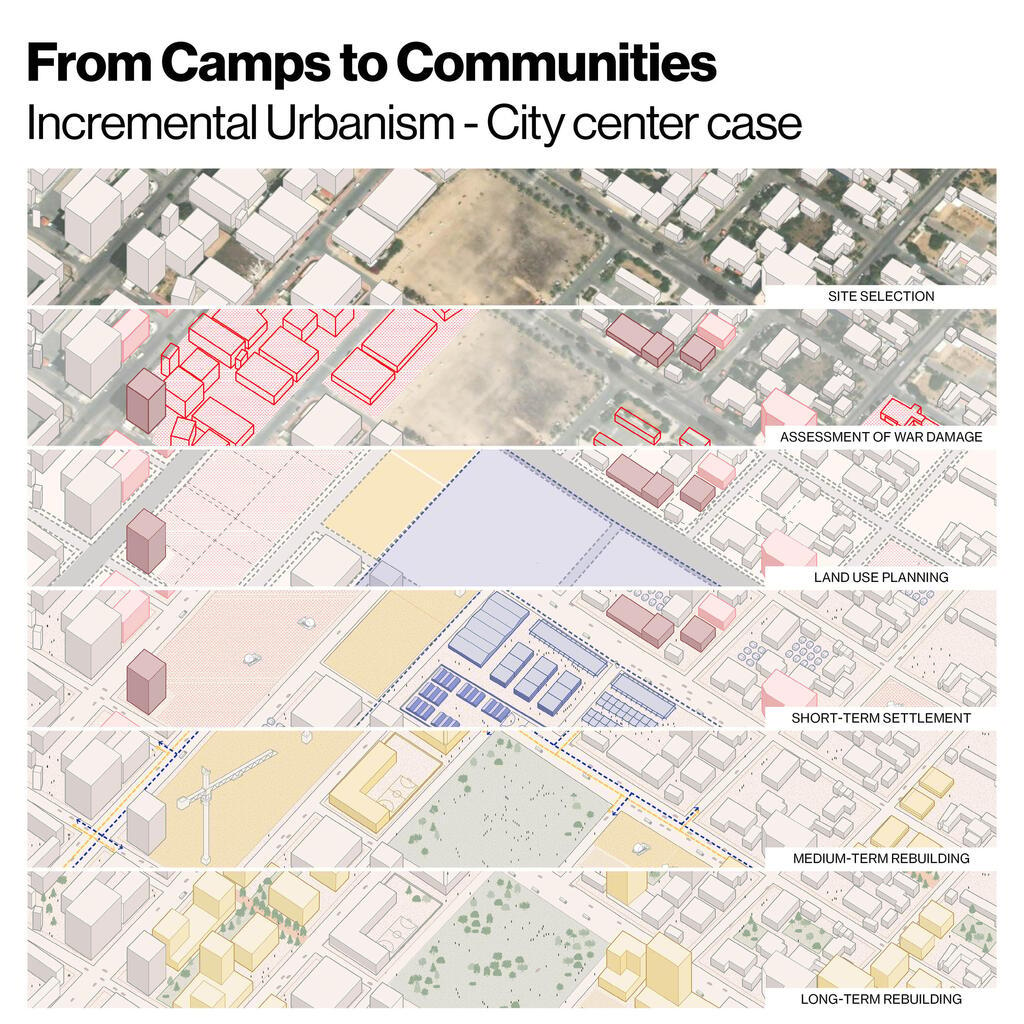
In previous rounds between Israel and Hamas, a significant amount of the concrete intended for the reconstruction of the Strip actually ended up in Hamas' hands and was used, among other things, to build tunnels. How can we ensure that this time the reconstruction process will be conducted in a way that the resources will reach their civilian destination and not be used for terrorist purposes?"From a security and governmental perspective, the plan proposes that Hamas will be completely out of the picture. The ambition is to have one governing body that will include the Palestinians along with neighboring and involved countries. The hope is that this body will have enough power to ensure that there will be no security problems and that the assistance will be for reconstruction purposes only. I believe that our method of planning the new neighborhoods in an orderly manner, which involves governmental elements, will succeed in reducing the possibility that Hamas will be involved in illegitimate steps."
Trump has declared a vision to turn Gaza into a "Riviera of the Middle East" with hotels, shopping malls, and towers. How realistic do you think this idea is under current conditions?"I'm sure that the Gazans also want to build towers on the coastal strip. As a vision, I really don't think it's a bad idea for Gaza to be a thriving city that will enjoy economic opportunities. The path to get there is still unclear, and I myself have not yet seen any serious plan with a clear strategy. Our plan tries first to focus on the long-term implications of making urgent decisions in the short term. We need to make very critical decisions that concern huge amounts of people and an unimaginable amount of destruction. Before towers and visions, the Strip must first be rebuilt - there are about 10 tons of unexploded explosives among the rubble and they need to be cleared. This is an unprecedented engineering and organizational project."
"This is a very complex project, also emotionally"
Although the initial plan began before October 7, the fact that an Israeli-American architect is leading an initiative to rebuild Gaza may be controversial among many Israelis, who will have difficulty understanding why Israelis should be involved in this effort. For Rotenberg, the war in Gaza was also a shock, but he believes that is precisely why the project is so important."It is a very complex project, also emotionally," he says."The last year and a half have been difficult and sad for me, as for all Israelis. From a personal perspective, this is a project unlike any work I have done before."
Despite the emotional complexity of the project, Rotenberg explains that ultimately he is first and foremost a planner, and his work is carried out with complete professionalism, without any political affiliation."We act without bias and think about the good of the Palestinians and Israelis together," he says, emphasizing:"We are a completely professional team, examining reality in a balanced and responsible manner, and presenting the best recommendations and decisions imaginable."
Do you collaborate with Israeli officials in your work? "There is no official cooperation with Israel, but we definitely consult with Israeli, Palestinian and international officials to get ideas and hear their opinions. I think there is a critical need for professional collaborations that involve a variety of voices and identities in this type of work, especially given the very complicated situation we find ourselves in. The very fact that the fighting is still ongoing and many hostages remain in captivity increases the sense of commitment to developing solutions that promote peace in the short term and stability in the long term."
Gaza 2030 – The Egyptian Plan
Alongside the international plans for the reconstruction of the Gaza Strip, Egypt also published its own comprehensive plan a few months ago, which has also received the approval and support of other Arab countries. The plan, which bears the ambitious name"Gaza 2030", lays out a detailed future vision for the redesign of the Strip, and is spread over 91 pages that include engineering diagrams, simulations and development plans. According to the Egyptian outline, about 25% of the Strip's area will be allocated for housing - with the construction of more than 1,700 new residential buildings that will be spread across several neighborhoods and will include about 42,000 housing units.
But not only residences are in focus - the plan aims to create a complete fabric of life and develop agricultural areas, workshops, a wide transportation network, logistics areas, government and administrative complexes, public service facilities and even the establishment of resort villages along the seashore. Beyond the physical planning, the Egyptian document also includes an in-depth historical analysis of the situation in the Strip following the war and attempts to rebuild devastated areas around the world. To this end, it refers to models of cities that were destroyed in wars and rebuilt - such as Hiroshima in Japan, Berlin after World War II and Beirut in Lebanon.
This article has 0 comments in 0 discussions.

